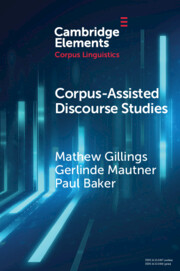Element contents
Corpus-Assisted Discourse Studies
Published online by Cambridge University Press: 20 March 2023
Summary
Information
- Type
- Element
- Information
- Series: Elements in Corpus LinguisticsOnline ISBN: 9781009168144Publisher: Cambridge University PressPrint publication: 06 April 2023
References
Accessibility standard: Unknown
Why this information is here
This section outlines the accessibility features of this content - including support for screen readers, full keyboard navigation and high-contrast display options. This may not be relevant for you.Accessibility Information
- 67
- Cited by
